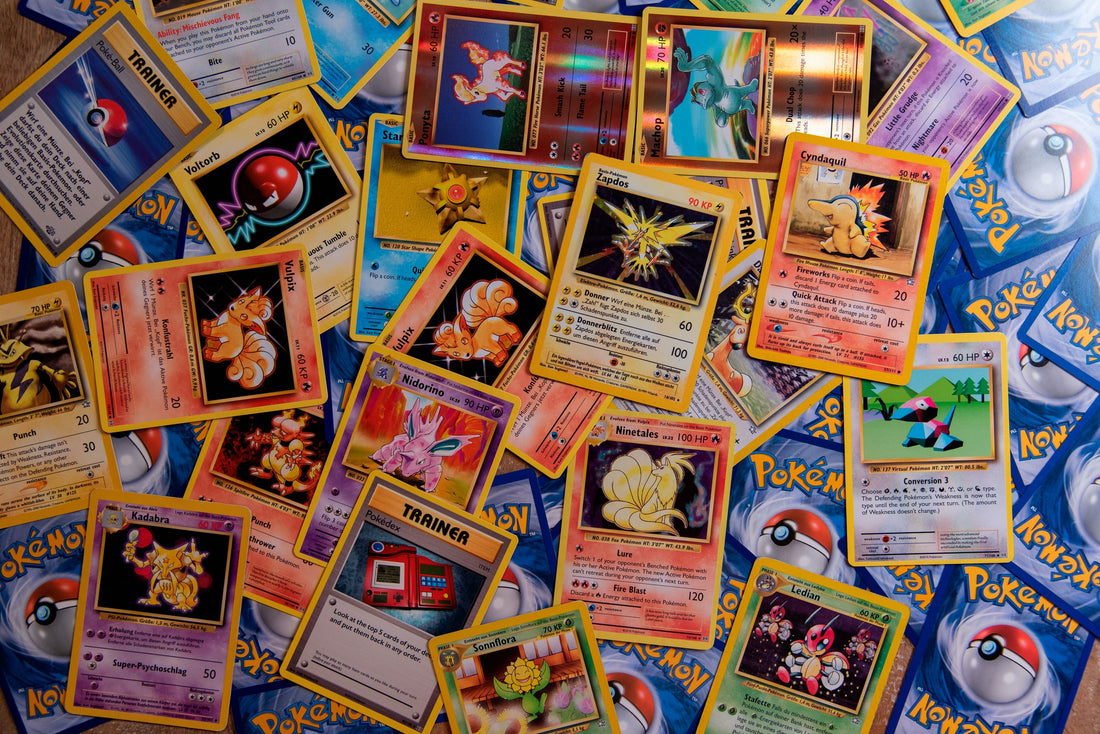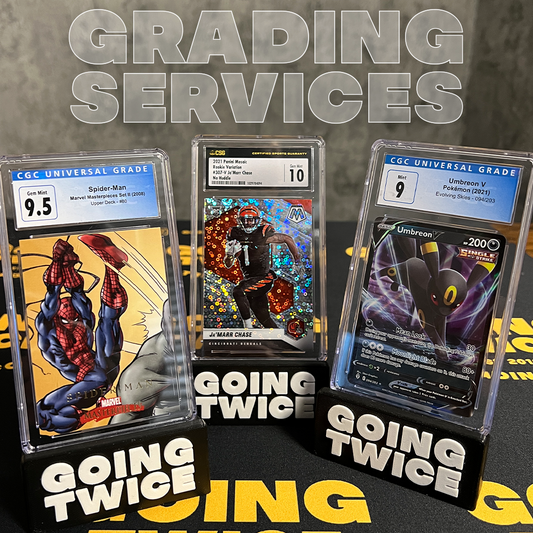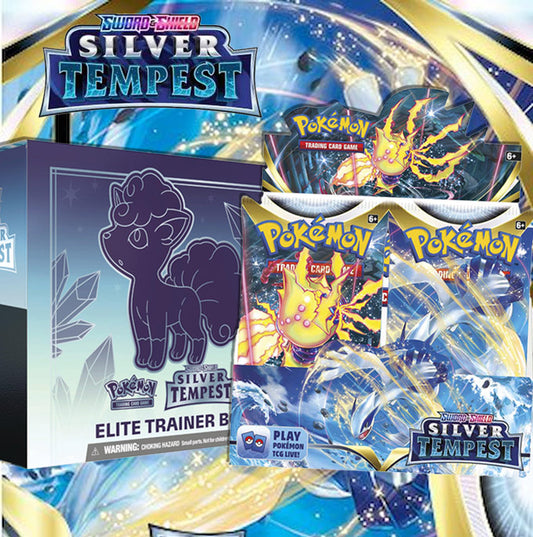
Gear every Poké collector needs
Share
So you want to collect Pokemon cards? Or you already collect but want to take it to the next level? We’re going to set you up with all the gear you need to get going! There are a few key areas that are particularly important and that’s where we’ll focus our attention.
Card Handling
So much of the condition of cards is dependent on the quality of the printing, cutting, and packaging directly from the factory - sometimes it’s amazing and other times it sucks. While those things are out of our control, you should always check the condition of any sealed product you are opening and avoid product that looks like someone dropped kicked it down a flight of stairs or someone’s Nana steamrolled it in her Jazzy.

A nice playmat is a must for opening packs, it gives you a (hopefully) clean, soft surface to put your cards on as you open them. There are lots of different kinds of mats out there and you can even get some in Pokemon product such as the Marnie boxes from Champion’s Path. It’s easy to get hooked on buying mats or tracking down cool vintage ones with your favorite starters. I like to store my mats rolled up in a plastic container when not in use so they don’t pick up dust and other bits.
@goingtwice_com Some people don’t know how to treat their cards smh my head #pokemontcg #pokemontcgcommunity #pokemon #charizard #comedy ♬ original sound - Going Twice Inc
Now there is a definite art to opening Pokemon packs to give your cards the best chance possible of staying in pristine condition. You want to either carefully cut the top of the pack (make sure no cards are at the top) with scissors or pull open the seam without bending or crunching the cards. You’re not handling a Rembrandt so gloves are not necessary and are, in fact, not recommended. They can dull your sense of touch and cause you to be rougher than you would otherwise be.
Once you have the pack open, carefully remove the cards by holding the edges (not the surface). It is up to you how careful you want to be with the non-holos but history has told us that someday, they could, possibly, maybe be worth something so don’t just chuck ‘em. You do want to be especially careful with the holos, full arts, secret rares, etc and try not to touch the surface of the holo, dent the card with your nails, bend the card, or nick the edges.
From here, you have two primary options - stick them in a binder or sleeve them. Binders appeal to the collector in a lot of us as they give you a nice way to view all your cards in an organized, visually appealing way. They also condense the storage of your cards into something manageable especially if you have a lot of cards or allow you to easily separate by set.
You definitely want to avoid putting cards in binder pages back-to-back - trust me, they will stick together or at least rub edges and hurt the card condition. Each card should have its very own pocket and you want to be very careful sliding them into and out of the binder pockets. Three ring binders are not recommended because they can end up denting cards if the pages don’t lay flat or end up pressing against the rings. Instead use a binder where the pages are attached via the binding.
You can’t add pages to these binders but they are much safer for your cards. I personally don’t put any cards in binders because the risk of damage wrangling them in and out of the pockets is too great (I use boxes, more about that in a minute).
So that leaves sleeving… So you can’t go wrong with penny sleeves, they are cheap and roomy (for your cards). I know some folks love perfect fits (super snug fit) but I think the risk of damage is again pretty high getting the cards into and out of them. Anytime you bump the edge of the card against the sleeve edge, you risk nicking it leaving whitening. You can use any kind of sleeve really including the cool Pokemon ones that come in ETBs (although those don’t let you see the back of the card). There are also sleeves with built in tabs that allow you to easily pull the sleeved card out of card savers or top loaders - more about that later. The main takeaway here is that sleeves protect your cards from most forms of damage - scratching, small amounts of moisture, dust, your dirty hands, etc.
Storage

Let us all hope we have learned from our childhoods and no longer carry our Pokemon cards around in our pockets, store them in boxes under the bed, or leave them out where the family dog can chew them up. My dogs have only ever chewed up Pokemon cards once, it was a Base Set 2-Player Starter Deck and none of them fessed up but I think I know who did it... The goal here is to store your cards in a way that preserves them while still allowing you to enjoy them. By now you might know that my preference is to sleeve cards but where to go with them next? In the interest of not damaging my cards, I like to house them in fairly tight fitting boxes such as using empty ETB boxes (I’m cheap and I have a ton of them lying around) or boxes made specifically for housing cards that don’t have a lot of wiggle room.

These come in single row up to five row versions. I prefer the variation that allows your cards to fit standing up as opposed to on their side. The key with this kind of storage is to ensure that the cards are snuggly lined up in the box without room to slide or fall over. I use the packaged energy bricks that come in ETBs to fill any extra space (again, cheap and what else are you going to do with all of those bricks?).
If you are considering grading your cards, you might want to put them right into card savers or top loaders and these fit well into boxes made specifically for graded cards. If you want to get crazy, go ahead and organize them in card order, by set, and/or by condition. I am personally a fan of using card savers because the majority of my cards will eventually make their way to CGC for grading but card savers suck if you need/want to take your cards into and out of them multiple times.
In that case, you are better off with top loaders and using sleeves that allow you to easily pull the card out. Either way, both of these methods help protect your cards from moisture and getting banged up.
All raw (ungraded) cards whether they are in a binder, sleeved, or in top loaders/card savers, should be kept in a dry, moderate environment and out of the sun!
Bulk Boxes
Everyone in my household knows how I feel about bulk (non-holo commons, uncommons, and energies)... I hate it passionately. But you still need some way to manage all the bulk that you amass if you are regularly opening product or buying collections. I recommend the same strategy as above - ETBS or bulk boxes that can safely store your cards but also allow for some kind of organization or labeling. And if you hate bulk, like me… Check out some of the reputable businesses that accept bulk either for monetary or trade-in value. If you’re really feeling motivated, get on TrollandToad or TCG Player and sell bulk singles - make that bulk work for you! I’d prefer to have a bonfire with it but again, you never know when the 27 sizzlipedes you got in Sword & Shield might be worth something.
Graded Cards
If you love slabs, like I do, you might have a lot of them and need some gear just for them. Graded cards look amazing when you first get them back from CGC or PSA but they can get scratched and scuffed up pretty quickly. I keep my slabs in team bags (think of them as sleeves for slabs). They are inexpensive and keep those slabs looking minty! I also use micro-cloths to gently clean my slabs when they get fingerprints or dust on them.
Slabs can be stored in single or two row boxes or you can find some very cool ways to display your cards from custom holders to frames. CGC’s new card registry makes it super easy to keep track of all your graded CGC cards and is a great way to have a running inventory of your slabs.
Tracking your Collection
The tool that I would definitely recommend every collector get is a method for keeping track of your cards. Not only will you know which cards you have, you’ll also know what you’re missing. There are some great apps out there that allow you to mark off cards in your set such as TCG Player and Pokellector. They do have some limitations such as no way to mark reverse holos versus non-holos in the same set and are sometimes limited to English and Japanese sets but no other International variations. As I mentioned previously, you can also take advantage of CGC’s graded card registry to keep track of your graded CGC cards. I also personally use Google sheets (spreadsheets) to keep track of all my graded cards and what I paid for them or what I spent on raws + grading. There are definitely times when I don’t even want to think about how much I’ve spent on cards but at the same time, when I complete a set, it’s satisfying to know that I successfully completed it but also what it took to do it. There have definitely been times where I know I paid waaay too much for a card so I keep an eye out for a really good deal on the same card in the future. That way, I can average out the cost of the two cards together and feel better about the purchase. We’ll talk about strategies for making money with your collecting and how to strategically collect in future posts.
Happy collecting!



